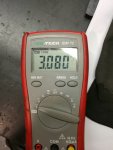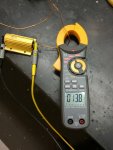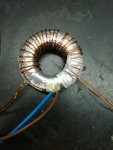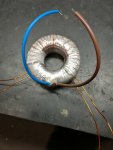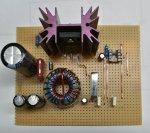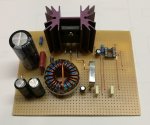I am building an Argon Laser Pulse Tester based on the Professors Argon Design. The Professor's Homebuilt Lasers Site - Argon Lasers
Stage one is a transformer for the fillament. In Australia we have 240 Volts which I could not find a suitable transformer to use for the fillament. No problem. Just modify a 240 Volt Toroid transformer.
I bought an 80 va 240 Vac to 2 x 12 Vac Toroid. Plenty big enough for a fillament supply.
Remove the outer layers of insulation.
Remove the secondary windings. Carefull not to damage anything.
Wound about 10 turns of 1mm insulated wire on the transformer so I can measure and calculate how many turns I would need. Comes out to be 13 Turns for each of the 1.55 Vac windings.
Wound 2 windings of 15 AWG cable onto the transformer. 13 Turnes each.
Time for some testing. I have a 0.22 Ohm 100 Watt resistor to use for the test. Fired it up. 13.8 Amps at 3.08 Volts. Almost perfect. The manual for the JSDU Power supply states it should be 3.1 Volts +/- 0.2 Volts.
Reinstall all the insulation on the transformer.
Here are the Pics so far of the Fillament transformer and the test shots.
I will keep this thread updated as I build it.
Stage one is a transformer for the fillament. In Australia we have 240 Volts which I could not find a suitable transformer to use for the fillament. No problem. Just modify a 240 Volt Toroid transformer.
I bought an 80 va 240 Vac to 2 x 12 Vac Toroid. Plenty big enough for a fillament supply.
Remove the outer layers of insulation.
Remove the secondary windings. Carefull not to damage anything.
Wound about 10 turns of 1mm insulated wire on the transformer so I can measure and calculate how many turns I would need. Comes out to be 13 Turns for each of the 1.55 Vac windings.
Wound 2 windings of 15 AWG cable onto the transformer. 13 Turnes each.
Time for some testing. I have a 0.22 Ohm 100 Watt resistor to use for the test. Fired it up. 13.8 Amps at 3.08 Volts. Almost perfect. The manual for the JSDU Power supply states it should be 3.1 Volts +/- 0.2 Volts.
Reinstall all the insulation on the transformer.
Here are the Pics so far of the Fillament transformer and the test shots.
I will keep this thread updated as I build it.
Attachments
Last edited:


